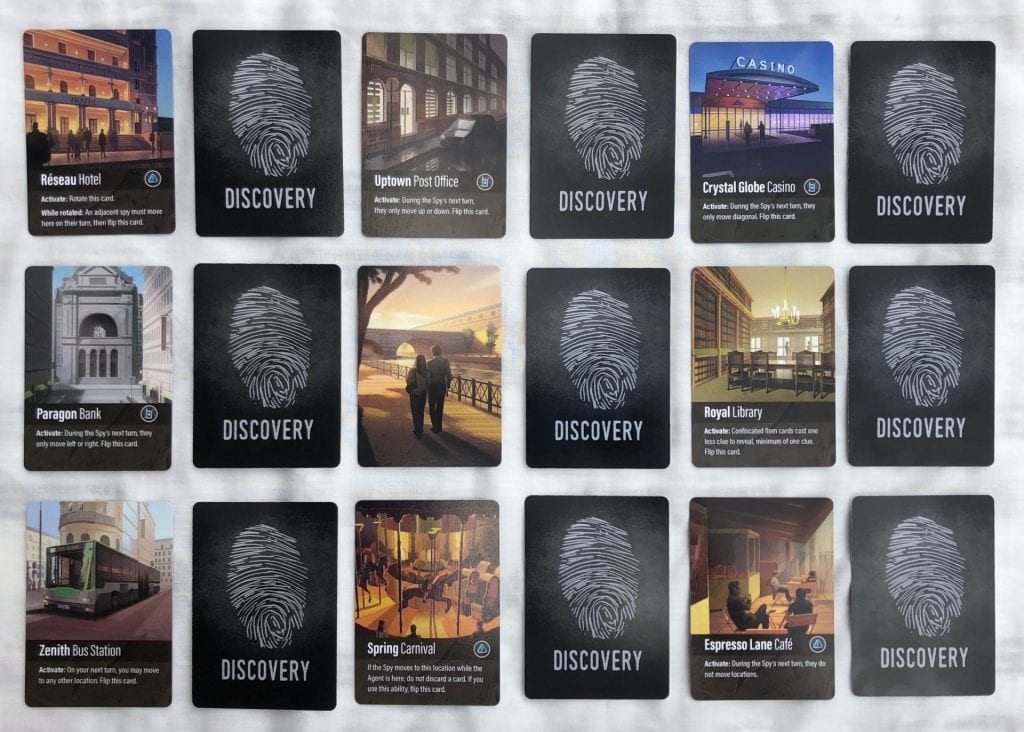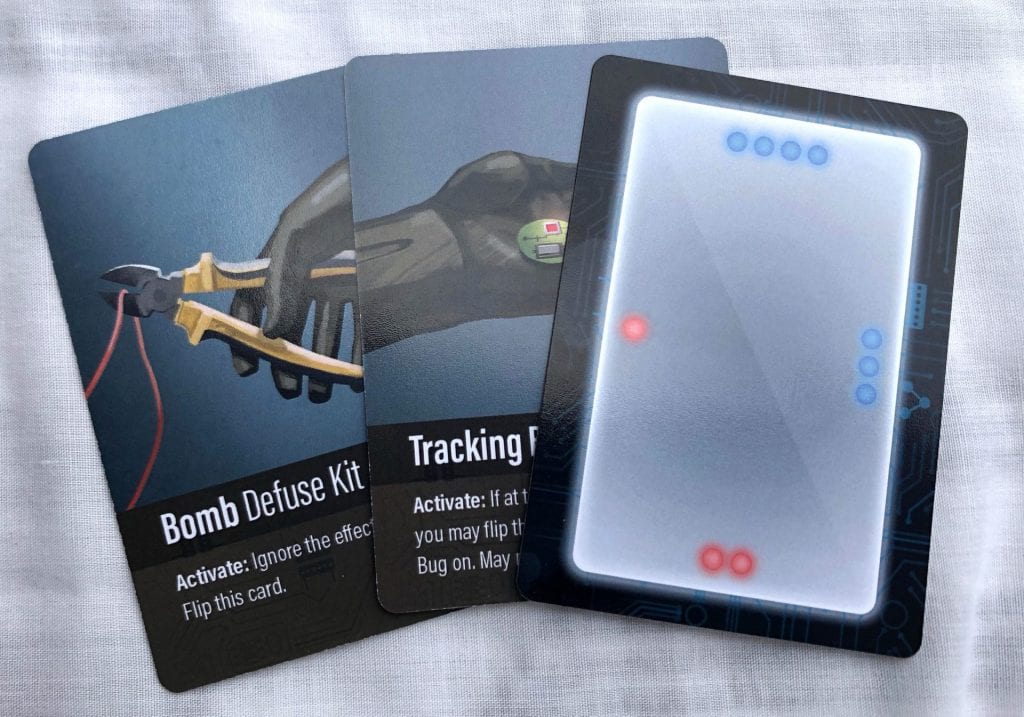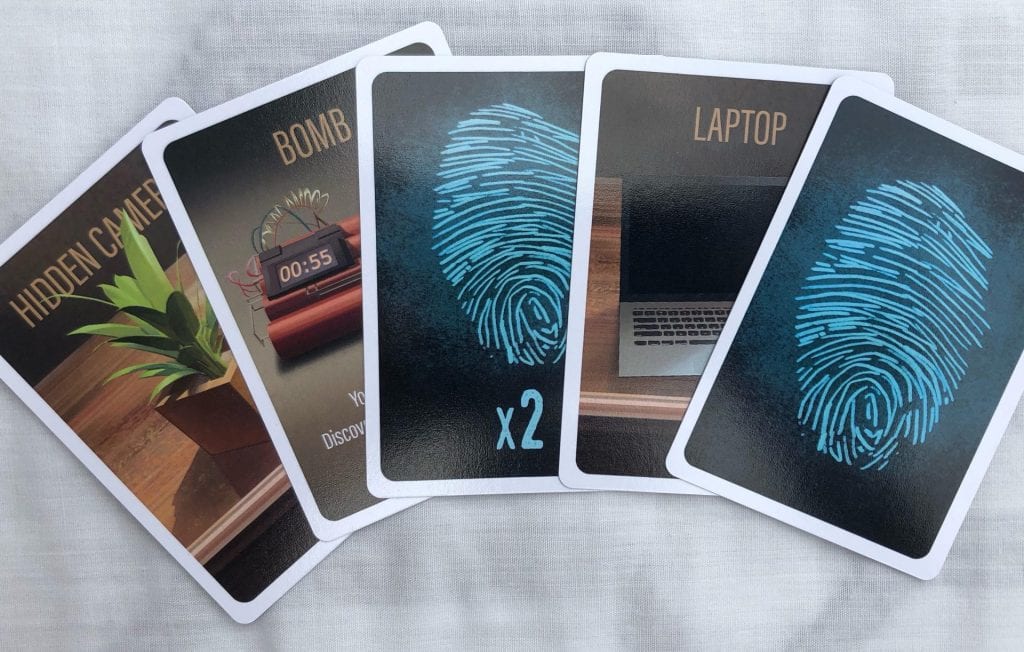[Editor’s Note: In the interest of transparency, readers should know that the author of this review has done paid freelance work for Button Shy Games owned by Jason Tagmire, who is a co-owner of Wonderspell Games.]
True Lies
Harsh Shadows – the debut venture from Wonderspell Games – is a solo-only spy thriller packed into a 54-card deck. Designed by Rachel Bruner, it initially appeared as a print-and play for 1-2 players which took second place in 2020’s 54-card design contest on Boardgamegeek.com. The published version from Wonderspell cuts the two-player option and refines the solo experience, adding all-new art by Ben Flores while reworking some mechanical aspects.
In a game of Harsh Shadows the player will be taking the role of a special agent tasked with chasing a villainous super-spy through a 3×3 grid of clandestine locations. The agent may move 1 “space” in any direction (orthogonal or diagonal) on their turn. Each location offers an ability — most of them one-shot effects — as well as a face-down Discovery card to pick up. These cards will always feature 1 of the following: a Bomb which forces the agent to discard something from their hand, a Clue icon, or a specific item of evidence.

The aim of the game is to gather the right pieces of evidence to put that ne’er-do-well away for good without turning in the Red Herring card that will cause the case to fall apart and the villain to escape. During setup, the player deals a separate set of item cards into 3 face-down piles. There are 3 cards assigned to Evidence, 4 to False Leads and 1 to the Red Herring.
Each item the player collects during play thus falls into one of these categories. Evidence is the one that really matters; the player needs all 3 Evidence cards in their hand to make a successful accusation and win the game. They may or may not also hold any False Leads. The Red Herring is the one to watch, though: if the player holds the Red Herring item in their hand when they accuse the spy, they lose regardless of whether they also have the evidence. It’s the shred of reasonable doubt that sinks an otherwise airtight case.

To determine which pieces of evidence are needed to convict the spy, the player will trade in sets of Clue icons to reveal a card in any pile. Each pile requires a different number of Clue icons, allowing the player to decide how much and what kind of information they can afford to gather before making a final accusation. Even under ideal circumstances the player can’t see all of the hidden cards as there simply aren’t enough Clue icons available.
Get Smart
Of course, a good spy thriller isn’t just about assembling evidence. An accusation does no good if the agent can’t, y’know, literally catch the spy. After the agent’s turn — which consists of a mandatory move and a series of optional abilities like turning in Clue icons and activating their location — the spy gets to move. To do this the player flips over a card from the spy’s movement deck to reveal two arrows: one large and one small. The spy first attempts to move 1 space in the direction of the big arrow, then if that fails the small arrow, and if both of those fail they’ll rotate the card 180 degrees and try again in the same order. This opens up a lot of movement possibilities for the spy each turn using a slender 9 cards. Since some cards are rotated during shuffling, players can never quite know how the spy will move.

That matters for two reasons: firstly, if the spy ever moves into the agent’s location or vice versa the agent must discard a card from hand; secondly, when the spy moves into a location they place a new Discovery card on that space (up to a maximum of 2 in any given location). This could be the piece of evidence the player needs or another one of those discard-inducing Bombs. Nobody said this mission would be easy!
The player does have access to some high-tech tools to help them along. One of those is a Bomb Defusal Kit, which lets the player skip the effect of a single Bomb. This tool is almost always used in the early phase of the game when Clues are hard to come by. More importantly, the player has a Tracking Bug that they need to place on the spy in order to make a successful accusation. To do this, the player must leave the Bug card on one of the marked locations and wait for the spy to land on that spot. Once they do the Bug is active and can be used up to twice to reveal the spy’s next movement card.

Having bugged the spy and (hopefully) collected the necessary evidence, it’s time for the player to make the final accusation. To do so they’ll need to corner the spy at one of the secure locations and then move into the spy’s space. The various location abilities often come in handy here, shunting the spy towards one spot or another or preventing them from moving altogether. Once the agent reaches the spy, they can finally reveal any unrevealed cards in the Evidence and Red Herring piles to determine if they won the game!
Spies Like Us
Rachel Bruner has an excellent reputation in the print-and-play community for her beautiful homemade games. While this is a professionally made production, it’s clear that her design and concept set a good foundation for the final version. Ben Flores’ artwork is fantastic and the theme fits perfectly — there are moments of cat-and-mouse tension that make the experience feel like a classic spy thriller. Most games start with the agent trying to stay out of the criminal’s way and end with a frantic race to put all the pieces together before it’s too late. I’ve had a few games where the crook just barely slipped through my fingers because I spent too much time making the perfect case. I’ve had just as many where I had to make a last-minute accusation with only a few cards revealed, hoping that I didn’t accidentally turn in the dreaded Red Herring.

There’s a surprising amount of depth here, too. I’ll admit to being a bit shocked at how simple the game was at first blush. After a few plays, I began to appreciate some of the nuance that I hadn’t seen before. I love the clue system in particular. Every game gives me the choice to pay a premium for positive knowledge or skate by with just knowing what to avoid. Saving a Clue card to pitch in case of an untimely Bomb or unexpected spy move can help, but that’s one less Clue that can be used for information. There’s so much flexibility in how the player navigates each game.
On harder difficulties I began to appreciate that the movement aspect of the game is arguably more important than the evidence. A well-timed location use or a perfectly-placed tracking bug can make all the difference between loss and victory. Knowing when to activate the tracking bug’s ability to foresee the spy’s movement can be hugely helpful if you can get it right, though a player with a good memory might be able to guess at the spy’s movement just by knowing the deck. There are a variety of paths to success here, and while the game isn’t wildly different from play to play I still enjoyed experimenting with approaches to see what worked for me.
For Your Eyes Only
That said, the “big game” experience that Harsh Shadows provides is marred a bit by being cards-only. I’m truly impressed by the number of ways those 54 cards are used. Cards are used as locations, as characters, to determine movement, to track the final turns, and many more. Unfortunately, that variety ends up making setup a little more finicky than I would like for a light solo game. One of my pet peeves is having to shuffle a very small set of cards (5-10, roughly) and Harsh Shadows requires doing this multiple times per setup then occasionally again throughout the game. The Discovery cards are particularly annoying, as getting the right distribution of Bombs at setup means a fair amount of shuffling, splitting, and reshuffling before every game. It makes perfect sense from a design standpoint but I found it a touch tedious.
And while it might not fit the Wonderspell ethos, I added a pair of small meeples to the box and found they greatly improved the experience. With the playing area packed full of cards, picking up the agent and spy cards each turn – without moving the cards they’re laying on or bumping the piles of cards around them – can occasionally be frustrating. There’s no way to easily slide, scoop, or flip the cards into position if your table or your fingers aren’t cooperating.

Lastly, it’s worth mentioning that while there is a lot of enjoyment to be gleaned from Harsh Shadows it is still a relatively light game. I don’t mind that – I have lots of room in my collection for accessible and thematic puzzles I can engage with for a half-hour or two. Heavy solo players might find it a little thin however. There are no grand strategies to implement or complex mechanics to manipulate. It’s a relaxing, reactive experience with gorgeous art that still manages to hit the right beats for a well-told spy story.
If that sounds like your kind of thrill, then Harsh Shadows will absolutely catch your interest. Head on over to Kickstarter now and capture your copy today!











Add Comment